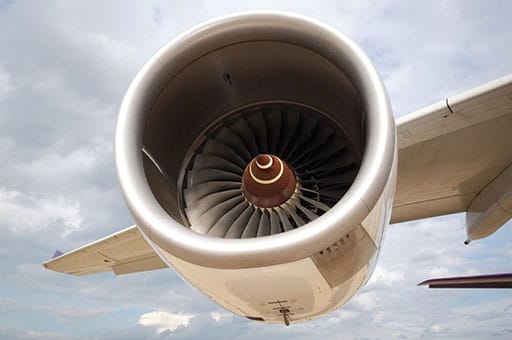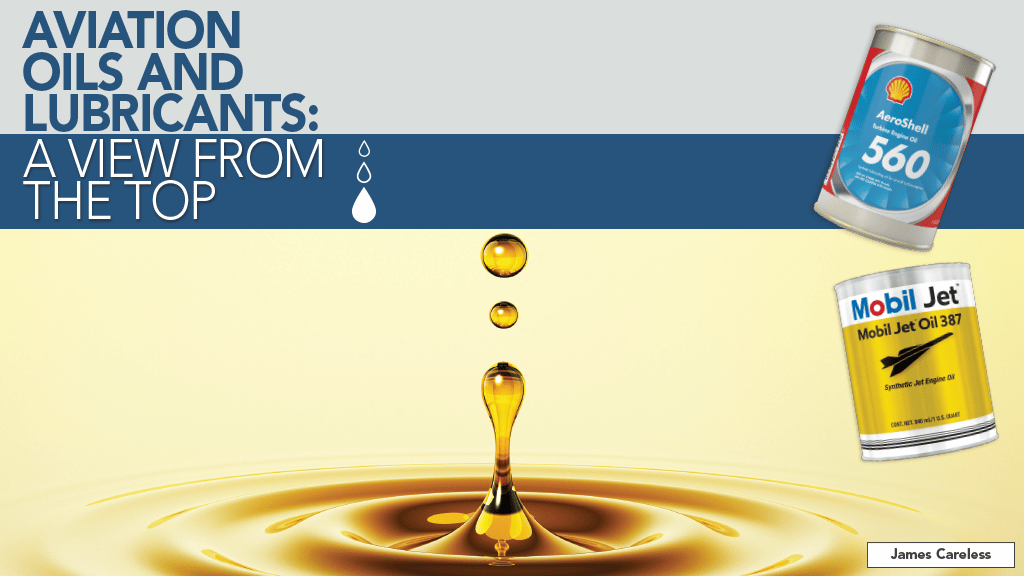The quest to increase commercial airliner range while cutting fuel consumption is being led by the high performance engines on these aircraft. This fact puts a heavy responsibility on companies such as ExxonMobil and Shell Aviation Lubricants, who make the oils and lubricating substances that keep these engines running safely and smoothly.
To get a top-level view of the challenges associated with this responsibility, Aviation Maintenance magazine was fortunate to speak with the people in charge of these efforts. They are Edward L. Barnes, Global Chief Engineer of ExxonMobil Aviation Lubricants; and Vincent Begon, General Manager of Shell Aviation Lubricants. The following is a roundtable discussion based on their answers.
Aviation Maintenance: What kinds of demands are modern oils and lubricants having to cope with on commercial airliners, such as higher engine temperatures on ultra-long-range aircraft such as the Airbus AS350-900 and Boeing 787?
Vincent Begon: Many advances in commercial airliners have taken place over the last few decades which have put heightened demands on modern oils and lubricants. More modern maintenance practices and improvements to engine performance through efficiency gains in fuel consumption have resulted in higher operating temperatures and pressures, creating more severe lubricant operating conditions.
The rise of ultra-long-haul travel in particular has resulted in the need for engine oils with very good (and improved) thermal stability since this type of travel inevitably creates higher temperatures in engines, which can have a significant impact from a maintenance perspective. One consequence is that the higher engine temperatures can increase the temperature of the turbine engine oil (TEO) being used. This can have a negative impact on TEOs not designed specifically for such conditions, potentially resulting in unwanted carbon deposits in the engine – a process otherwise known as coking. This can be very costly from a maintenance perspective.
Choosing the right TEO, notably third generation TEOs such as ASTO 560, is one of the most effective ways for airlines to handle the maintenance pressure of ultra-long-haul flight on their engines. Just as the trend towards longer flights is the product of decades of manufacturing advancements, engine oils have likewise been adapting over this time to continue to service the requirements of the latest engines. While turbine engine OEMs are now moving away from standard performance oils to high performance oils, many airlines continue to use standard, second generation oils rather than third generation oils which are designed to prevent such coking issues.
Edward L. Barnes: Higher engine temperatures is not a demand or a concern across the board. It is engine design specific. For example, when it comes to the engines on the 787, there’s a choice. You could have the Rolls Royce Trent 1000, or the General Electric GEnx-18.

Now the engine OEMs take different approaches to designing their engines, and that results in different levels of demand on the lubricant. The Rolls Royce engines tend to be a little hotter — it’s part, part and parcel of their path to efficiency. (In fact) All of these new engines have higher gas path temps, the RR Trent 1000, XWB and 7000 models have higher lubricant temperatures because of their design details. That will limit the types of oils that are allowed or approved for some of the newer Rolls Royce engines, such as our Mobil Jet Oil 387.
Now, as I said, the OEMs take different approaches here. For example, General Electric’s GE9X engine, which will be on the B777X aircraft when it enters service, does not place these same kinds of demands on the lubricant. The lubricant temperature is simply not as hot.
So the spectrum of approved oils is broader there. They allow those standard oils for those engines, and standard oils are working very well in many other new engines already in service, such as the PW1110G, the CFM LEAP-1A and -1B. So there’s not a consistent trend across the new engines that all of them require higher performance oils. That’s not true.
Aviation Maintenance: What is coking, why does it happen, and what damage does it do to engines?
Vincent Begon: One key maintenance challenge which occurs as a result of selecting an engine oil that cannot withstand the operating conditions of the engine is coking. This is essentially the build-up of unwanted carbon deposits, formed when oils break down under high temperatures.
If preventative measures are not applied, coking can be costly and unsafe. Carbon deposits can block oil filters and pipes, and in extreme circumstances, blocked filters can lead to oil starvation or carbon in the oil being fed to the bearings, resulting in bearing failures. Blocked oil scavenge tubes can also lead to engine fires.
Aviation Maintenance: What other problems can occur with aircraft if aviation oils and lubricants aren’t sufficient for their tasks?
Edward L. Barnes: Well, load carrying is always important. You need to be able to protect bearings and loaded contact surfaces of gears and accessory gearboxes.
That has not been a problem in the industry. It’s something we’ve coped with. Our standard oils carry load very well. The older MIL-PRF-23699 HTS oils also do the job and that’s accomplished with additives.
One area of particular trouble in the past has been the interaction of lubricants with seal materials — in particular, fluorocarbon, which is commonly known by its trademark name of Viton. The wrong species of Viton, combined with the wrong type of turbine oil with some additives can cause issues. The seals can degrade, they can swell, they can soften, they can fail.
Preventing this from happening was featured very prominently in our design of Mobil Jet Oil 387. We understand the chemistry of that seal interaction issue historically, we learned from it, and we designed a product which is very benign to seals, which can’t be said for all of the competitive products.
Vincent Begon: The other key challenge associated with using the incorrect oils and lubricants is elastomer compatibility. Whilst some antioxidants can provide good thermal stability and low coking propensity, some can be aggressive to certain elastomer materials used in some engine oil systems. If an oil is incompatible with an elastomer, it can lead to degradation, with cracking or deterioration of rubber ‘O’ rings which can lead to leaks, high oil consumption, maintenance headaches and, by consequence, higher operating costs. Currently, ASTO 560 is one of very few market solutions found to work on most engines without degrading elastomers.
Edward L. Barnes: There are other issues to consider when an operator makes a lubricant conversion, such as deposit washout and the effects the new lubricant may have on seals. The operator should work with the OEM and the lubricant provider to understand the risks.
We understand those risks well, and conversion is a manageable process, but OEM guidelines must be followed.
Aviation Maintenance: What other challenges do you expect commercial aviation oils and lubricants to face in the future, e.g. with the emergence of eVTOLs?
Vincent Begon: In the short to medium term, eVTOLs will not significantly impact the existing civil commercial market. Initial eVTOL aircraft are designed to carry a small number of passengers or cargo over an inter-city range. Today, this market is served by buses, trains, cars and helicopters, hence the limited impact on commercial aviation oils and lubricants in the near future.
Edward L. Barnes: The pace of change in commercial aviation is very slow because of the conservative, risk-averse nature of the industry. The military is a different animal: They can experiment a little bit more and be a little bit more aggressive with totally radical technologies for propulsion engines.
Along with that will come different lubricants and coolants for those situations. But for commercial aviation, I don’t see a revolution coming. The same turbine oils that are in use today will probably be in use 20 to 30 years from now.
The introduction of electric or hybrid electric technology where you might have, let’s say, an APU that’s powered by hydrogen generating electricity for multiple electric fans – it’s probably going to use the exact same lubricant despite using different fuels like hydrogen or sustainable aviation fuels (SAF). The SAF products will not require a revolution in lubricants. The current technologies will work. There may be slight adaptations, some additional products coming down the pipeline, but I don’t see them being revolutionary. They will be very similar and compatible with what we’re using today.
Electric motors don’t use a lot of lubricant in most cases. They will have greased and sealed bearings. However, there may be specialized electric vehicle fluids in transmissions if the motor assembly has a transmission. This is what is happening in automotive technology: Most of the electric vehicles have transmissions that use specialized transmission fluids, and ExxonMobil is very heavily engaged in that development. We have the Mobil1 EV product line in development, and some of that chemistry may be adapted to aviation if there are electric driveline transmissions employed.
Aviation Maintenance: Going forward, what advances in oils and lubricants are you working on now, and to what end?
Vincent Begon: On the lubricants side of the business, we are investing in strengthening our supply chain, expanding our distribution and extending our product approvals. For example, in 2021 we added a grease manufacturing plant to our lubricant manufacturing network and formed new distribution partnerships in China, India and Latin America.
We are a lubricant supplier with high-performance products for all aviation customers, from light-sports aircraft owners to MROs. All products must meet minimum specifications, but not all approved products are the same, and some can make a significant financial difference so we’re continuing to work on communicating this to our customers so they can benefit.
We are also focussed on garnering support across the aviation ecosystem to drive the adoption of higher performance capability, fourth generation lubricants. Shell is working with engine, airframe and oil OEMs as well as airlines to ensure more oils are evaluated and approved for use so that airlines have a wide array of high performance oils and lubricants to choose from.
The same is also happening in the wheel bearing grease space, with Shell having developed the latest high performance wheel bearing grease, AeroShell grease 58, based on our successful lithium-based grease ASG33 technology. This solution is being worked on with airlines and wheel OEMs to secure full approvals for use but it’s a fantastic solution as it has been designed with the same technology as AeroShell Grease 33 and 64, meaning the three products together can cover virtually all the grease points in a commercial airliner and eliminate incompatibility issues that can otherwise arise when different greases are used together.
Edward L. Barnes: We are working on advances, but we can’t go into any detail because most of it is related to the military. Most assuredly, the ExxonMobil Technology and Engineering Company is heavily engaged with the US Air Force Research Laboratory, the US Navy, and various OEMs in developing new technologies. But they are on the drawing board along with the aircraft that they might be used in. It’s decades away in most cases.
Vincent Begon: One final note. At Shell, our target is to become a net-zero emissions energy business by 2050. This means reducing emissions from our operations and from the fuels and other energy products we sell to our customers.
As such, we recognise the need to decarbonise lubricants and are working on solutions, in partnership with OEMs, to fulfill the need for decarbonised oils and lubricants. Part of this means decarbonising our operations, which we’re doing by using post-consumer plastics in our packaging, for example, and installing solar photovoltaic panels on the roofs of seven lubricant plants in China, India, Italy, Singapore and Switzerland.


